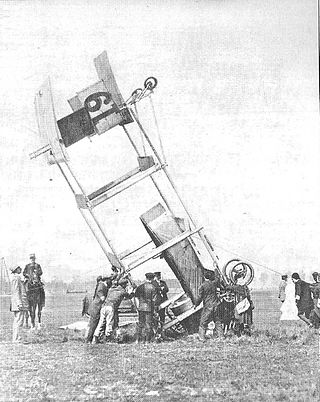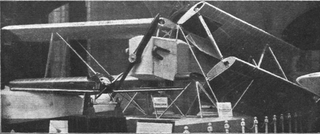
The Lioré et Olivier LeO H.242 was a monoplane flying boat aircraft designed and produced by the French aircraft manufacturer Lioré et Olivier. It was used for European passenger air services in the 1930s, including by the flag carrier Air France. One LeO H.242 was depicted near the end of Hergé's The Adventures of Tintin comic King Ottokar's Sceptre.

The Astra C was a 1912 French single engine biplane, manufactured by Société Astra at Villacoublay. In 1913, the Astra CM Hydro-avion three-seat floatplane version was used to make the world's first scheduled passenger-carrying flights.

The Latécoère 521 was a French six-engined double deck flying boat designed and manufactured by Pierre-Georges Latécoère. At the time of its completion, it held the distinction of being the largest aircraft to be built in France as well as one of the first large passenger aircraft capable of flying trans-Atlantic routes.

The Nieuport 12 was a French sesquiplane reconnaissance, fighter aircraft and trainer used by France, Russia, Great Britain and the United States during World War I. Later production examples were built as trainers and served widely until the late 1920s.

The Potez-CAMS 141 was a French long range reconnaissance flying boat of the late 1930s. Intended to equip the French Navy, only a single prototype was completed before the German invasion of France stopped production. That prototype did, however serve operationally from bases in French North Africa until scrapped in 1943.

The Lioré et Olivier H-190 was a biplane flying boat aircraft designed and produced by the French aircraft manufacturer Lioré et Olivier.
The Nieuport-Delage NiD 38 was a touring aircraft built in small numbers in France in the early 1920s. It was a single-bay biplane of conventional design with an enclosed cabin for two passengers and an open cockpit for the pilot.

The Breguet Type I was an experimental aircraft built in France in 1909. It was Louis Bréguet's first fixed-wing aircraft design. Breguet had previously had some success with two helicopter designs, one of which had been exhibited at the Paris Aero Salon in December 1908. Because of these machines, the Type I was at first known as the Breguet Type III.

The Nieuport 14 was a military reconnaissance sesquiplane produced in France during the First World War. The French Army deployed it in 1916 but the type was quickly withdrawn from front-line service.

The Lioré et Olivier LeO H-180 was a 1920s French two-seat flying-boat built by Lioré et Olivier.
The SNCASE SE-400 was a prototype French twin-engined coastal patrol floatplane of the Second World War. A single example was flown, but development was abandoned in May 1940 owing to the German invasion of France.

The SPCA Météore 63 was a biplane flying boat airliner designed and built by the French aircraft manufacturer Société Provençale de Constructions Aéronautiques (SPCA). It was the company's first aircraft, as well as the first seaplane to fulfil the strenuous conditions to secure a seaworthiness certificate of the first class and the first long distance seaplane to be procured by the French government.

The Potez-CAMS 160 was a one-off 5/13 scale flight model built in France, first flown in the summer of 1938 to test aerodynamic and hydrodynamic qualities of the Potez-CAMS 161 airliner and mail carrier, which was too large for detailed modelling in existing wind tunnels.

The Potez-CAMS 161 was a large, French six-engined flying boat airliner, designed to operate on the North Atlantic routes that were opening up in the late 1930s. Its development was almost halted by World War II. Just one was built and partially tested before its destruction by Allied forces near the war's end.

The Lioré et Olivier LeO 10 or LeO H-10 was a prototype French Naval reconnaissance aircraft built. Only one example of this two seat, single engine biplane floatplane was built.

The Nieuport 15 was a French World War I bomber aircraft. Due to disappointing performance the type was rejected and never entered service.

The four-engined Lioré et Olivier LeO H-27 was one of three French flying boats competing to carry mail over Air France's South Atlantic routes. Flying later than its competitors, it was not selected and only one was built.
The Goupy Hydroaeroplane was a floatplane developed by Ambroise Goupy in 1912, which was displayed at the 1912 Paris Aero Salon. It was described in Flight as being generally comparable to a Goupy biplane designed by Alphonse Tellier displayed the year before, except for the change from wheels to a pair of pontoon-style floats. Janes 1913 stated that at least one had been built in 1912, and that the company was producing around 30 a year, but actual production numbers are not known beyond the 1912 demonstrator. An editorial review of the 1913 Paris Aero Salon bemoaned the lack of advancement in Goupy designs, with no display of a seaplane.
The Bréguet 610 was a reconnaissance seaplane built in 1934 by the Bréguet company.
The SNCAC NC-420 was a French observation flying boat built by SNCAC in the 1940s. It was intended to operate from the ships of the French Navy, but although a single prototype was completed, it never flew.















